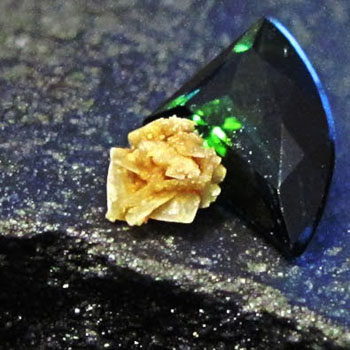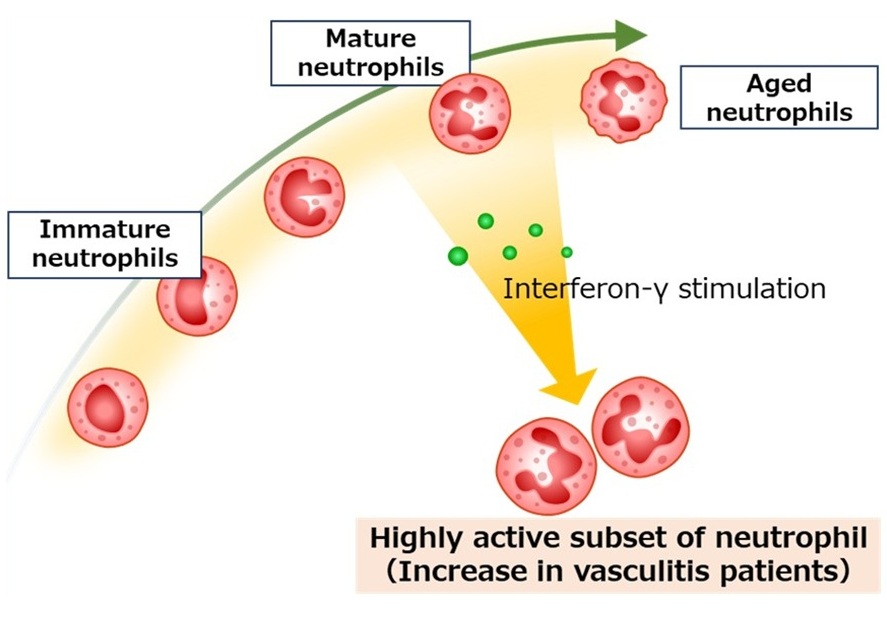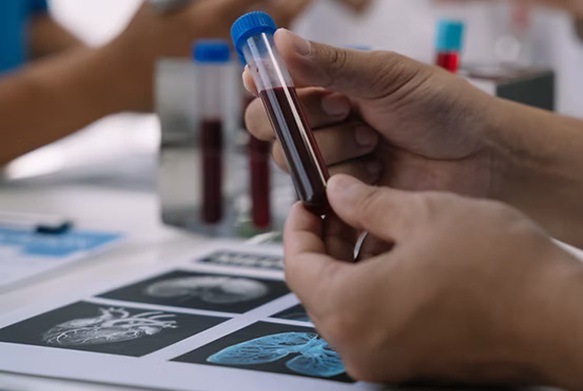Hydroxycitrate Potentially More Effective Than Citrate for Kidney Stones
|
By LabMedica International staff writers Posted on 18 Aug 2016 |

Image: A kidney stone (yellow) composed of calcium oxalate showing sharp edges (Photo courtesy of Wikimedia Commons).
The chemical hydroxycitrate (HCA) was shown in a recent study to be more effective for treating calcium oxalate kidney stones than the commonly used compound potassium citrate.
Calcium oxalate monohydrate is the principal component of human kidney stones and citrate (CA) is an often-used therapy, but hydroxycitrate (HCA) is not. In a study published in the August 8, 2016, online edition of the journal Nature, investigators at the University of Houston (TX, USA) used techniques of bulk crystallization, in situ atomic force microscopy, and density functional theory to compare the capacity of CA and HCA to prevent or even reverse the growth of calcium oxalate crystals.
The investigators reported finding a mechanism that differed from classical theory in that inhibitor adsorption on crystal surfaces induced dissolution of the crystal under specific conditions rather than merely reducing the rate of crystal growth. This phenomenon occurred even in supersaturated solutions where the inhibitor concentration was three orders of magnitude less than that of the solute.
Decrease in crystal size was explained by a hypothesis, generated from atomic force microscopy observations, that inhibitor–crystal interactions imparted localized strain to the crystal lattice and that oxalate and calcium ions were released into solution to alleviate this strain.
For HCA to function as a kidney stone treatment, it must be excreted in urine. The investigators reported that HCA ingested by non-stone-forming humans at an often-recommended dose led to substantial urinary excretion. In vitro assays using human urine revealed that HCA was as effective an inhibitor of nucleation of calcium oxalate monohydrate nucleation as was CA. These findings supported further exploration of the clinical potential of hydroxycitrate as an alternative treatment to citrate for kidney stones.
Senior author Dr. Jeffrey D. Rimer, associate professor of chemical engineering at the University of Houston, said that, "While this research established the groundwork to design an effective drug, questions remain. Long-term safety, dosage, and additional human trials are needed. But our initial findings are very promising. If it works in vivo, similar to our trials in the laboratory, HCA has the potential to reduce the incidence rate of people with chronic kidney stone disease."
Related Links:
University of Houston
Calcium oxalate monohydrate is the principal component of human kidney stones and citrate (CA) is an often-used therapy, but hydroxycitrate (HCA) is not. In a study published in the August 8, 2016, online edition of the journal Nature, investigators at the University of Houston (TX, USA) used techniques of bulk crystallization, in situ atomic force microscopy, and density functional theory to compare the capacity of CA and HCA to prevent or even reverse the growth of calcium oxalate crystals.
The investigators reported finding a mechanism that differed from classical theory in that inhibitor adsorption on crystal surfaces induced dissolution of the crystal under specific conditions rather than merely reducing the rate of crystal growth. This phenomenon occurred even in supersaturated solutions where the inhibitor concentration was three orders of magnitude less than that of the solute.
Decrease in crystal size was explained by a hypothesis, generated from atomic force microscopy observations, that inhibitor–crystal interactions imparted localized strain to the crystal lattice and that oxalate and calcium ions were released into solution to alleviate this strain.
For HCA to function as a kidney stone treatment, it must be excreted in urine. The investigators reported that HCA ingested by non-stone-forming humans at an often-recommended dose led to substantial urinary excretion. In vitro assays using human urine revealed that HCA was as effective an inhibitor of nucleation of calcium oxalate monohydrate nucleation as was CA. These findings supported further exploration of the clinical potential of hydroxycitrate as an alternative treatment to citrate for kidney stones.
Senior author Dr. Jeffrey D. Rimer, associate professor of chemical engineering at the University of Houston, said that, "While this research established the groundwork to design an effective drug, questions remain. Long-term safety, dosage, and additional human trials are needed. But our initial findings are very promising. If it works in vivo, similar to our trials in the laboratory, HCA has the potential to reduce the incidence rate of people with chronic kidney stone disease."
Related Links:
University of Houston
Latest BioResearch News
- Genome Analysis Predicts Likelihood of Neurodisability in Oxygen-Deprived Newborns
- Gene Panel Predicts Disease Progession for Patients with B-cell Lymphoma
- New Method Simplifies Preparation of Tumor Genomic DNA Libraries
- New Tool Developed for Diagnosis of Chronic HBV Infection
- Panel of Genetic Loci Accurately Predicts Risk of Developing Gout
- Disrupted TGFB Signaling Linked to Increased Cancer-Related Bacteria
- Gene Fusion Protein Proposed as Prostate Cancer Biomarker
- NIV Test to Diagnose and Monitor Vascular Complications in Diabetes
- Semen Exosome MicroRNA Proves Biomarker for Prostate Cancer
- Genetic Loci Link Plasma Lipid Levels to CVD Risk
- Newly Identified Gene Network Aids in Early Diagnosis of Autism Spectrum Disorder
- Link Confirmed between Living in Poverty and Developing Diseases
- Genomic Study Identifies Kidney Disease Loci in Type I Diabetes Patients
- Liquid Biopsy More Effective for Analyzing Tumor Drug Resistance Mutations
- New Liquid Biopsy Assay Reveals Host-Pathogen Interactions
- Method Developed for Enriching Trophoblast Population in Samples
Channels
Clinical Chemistry
view channel
‘Brilliantly Luminous’ Nanoscale Chemical Tool to Improve Disease Detection
Thousands of commercially available glowing molecules known as fluorophores are commonly used in medical imaging, disease detection, biomarker tagging, and chemical analysis. They are also integral in... Read more
Low-Cost Portable Screening Test to Transform Kidney Disease Detection
Millions of individuals suffer from kidney disease, which often remains undiagnosed until it has reached a critical stage. This silent epidemic not only diminishes the quality of life for those affected... Read more
New Method Uses Pulsed Infrared Light to Find Cancer's 'Fingerprints' In Blood Plasma
Cancer diagnoses have traditionally relied on invasive or time-consuming procedures like tissue biopsies. Now, new research published in ACS Central Science introduces a method that utilizes pulsed infrared... Read moreMolecular Diagnostics
view channel
Simple Blood Test Better Predicts Heart Disease Risk
Cardiovascular diseases (CVDs) are the primary cause of death worldwide. A large proportion of these cases could be prevented by addressing lifestyle and environmental factors such as smoking, poor diet,... Read more
New Blood Test Detects 12 Common Cancers Before Symptoms Appear
Bowel cancer is the fourth most common cancer in the UK, with over 42,000 new diagnoses each year. Detecting bowel cancer in its early stages can be challenging, and as the disease progresses, survival... Read moreHematology
view channel
New Scoring System Predicts Risk of Developing Cancer from Common Blood Disorder
Clonal cytopenia of undetermined significance (CCUS) is a blood disorder commonly found in older adults, characterized by mutations in blood cells and a low blood count, but without any obvious cause or... Read more
Non-Invasive Prenatal Test for Fetal RhD Status Demonstrates 100% Accuracy
In the United States, approximately 15% of pregnant individuals are RhD-negative. However, in about 40% of these cases, the fetus is also RhD-negative, making the administration of RhoGAM unnecessary.... Read moreImmunology
view channel
Stem Cell Test Predicts Treatment Outcome for Patients with Platinum-Resistant Ovarian Cancer
Epithelial ovarian cancer frequently responds to chemotherapy initially, but eventually, the tumor develops resistance to the therapy, leading to regrowth. This resistance is partially due to the activation... Read more
Machine Learning-Enabled Blood Test Predicts Immunotherapy Response in Lymphoma Patients
Chimeric antigen receptor (CAR) T-cell therapy has emerged as one of the most promising recent developments in the treatment of blood cancers. However, over half of non-Hodgkin lymphoma (NHL) patients... Read moreMicrobiology
view channel
Handheld Device Delivers Low-Cost TB Results in Less Than One Hour
Tuberculosis (TB) remains the deadliest infectious disease globally, affecting an estimated 10 million people annually. In 2021, about 4.2 million TB cases went undiagnosed or unreported, mainly due to... Read more
New AI-Based Method Improves Diagnosis of Drug-Resistant Infections
Drug-resistant infections, particularly those caused by deadly bacteria like tuberculosis and staphylococcus, are rapidly emerging as a global health emergency. These infections are more difficult to treat,... Read more
Breakthrough Diagnostic Technology Identifies Bacterial Infections with Almost 100% Accuracy within Three Hours
Rapid and precise identification of pathogenic microbes in patient samples is essential for the effective treatment of acute infectious diseases, such as sepsis. The fluorescence in situ hybridization... Read morePathology
view channel
Sensitive and Specific DUB Enzyme Assay Kits Require Minimal Setup Without Substrate Preparation
Ubiquitination and deubiquitination are two important physiological processes in the ubiquitin-proteasome system, responsible for protein degradation in cells. Deubiquitinating (DUB) enzymes contain around... Read more
World’s First AI Model for Thyroid Cancer Diagnosis Achieves Over 90% Accuracy
Thyroid cancer is one of the most common cancers worldwide, and its precise management typically relies on two primary systems: (1) the 8th edition of the American Joint Committee on Cancer (AJCC) or ... Read more
Breakthrough Diagnostic Approach to Significantly Improve TB Detection
Tuberculosis (TB) remains the deadliest infectious disease globally, with 10.8 million new cases and 1.25 million deaths reported in 2023. Early detection through effective screening is crucial in identifying... Read more
Rapid, Ultra-Sensitive, PCR-Free Detection Method Makes Genetic Analysis More Accessible
Genetic testing has been an important method for detecting infectious diseases, diagnosing early-stage cancer, ensuring food safety, and analyzing environmental DNA. For a long time, polymerase chain reaction... Read moreTechnology
view channel
Disposable Microchip Technology Could Selectively Detect HIV in Whole Blood Samples
As of the end of 2023, approximately 40 million people globally were living with HIV, and around 630,000 individuals died from AIDS-related illnesses that same year. Despite a substantial decline in deaths... Read more
Pain-On-A-Chip Microfluidic Device Determines Types of Chronic Pain from Blood Samples
Chronic pain is a widespread condition that remains difficult to manage, and existing clinical methods for its treatment rely largely on self-reporting, which can be subjective and especially problematic... Read more
Innovative, Label-Free Ratiometric Fluorosensor Enables More Sensitive Viral RNA Detection
Viruses present a major global health risk, as demonstrated by recent pandemics, making early detection and identification essential for preventing new outbreaks. While traditional detection methods are... Read moreIndustry
view channel
Cepheid and Oxford Nanopore Technologies Partner on Advancing Automated Sequencing-Based Solutions
Cepheid (Sunnyvale, CA, USA), a leading molecular diagnostics company, and Oxford Nanopore Technologies (Oxford, UK), the company behind a new generation of sequencing-based molecular analysis technologies,... Read more
Grifols and Tecan’s IBL Collaborate on Advanced Biomarker Panels
Grifols (Barcelona, Spain), one of the world’s leading producers of plasma-derived medicines and innovative diagnostic solutions, is expanding its offer in clinical diagnostics through a strategic partnership... Read more





















